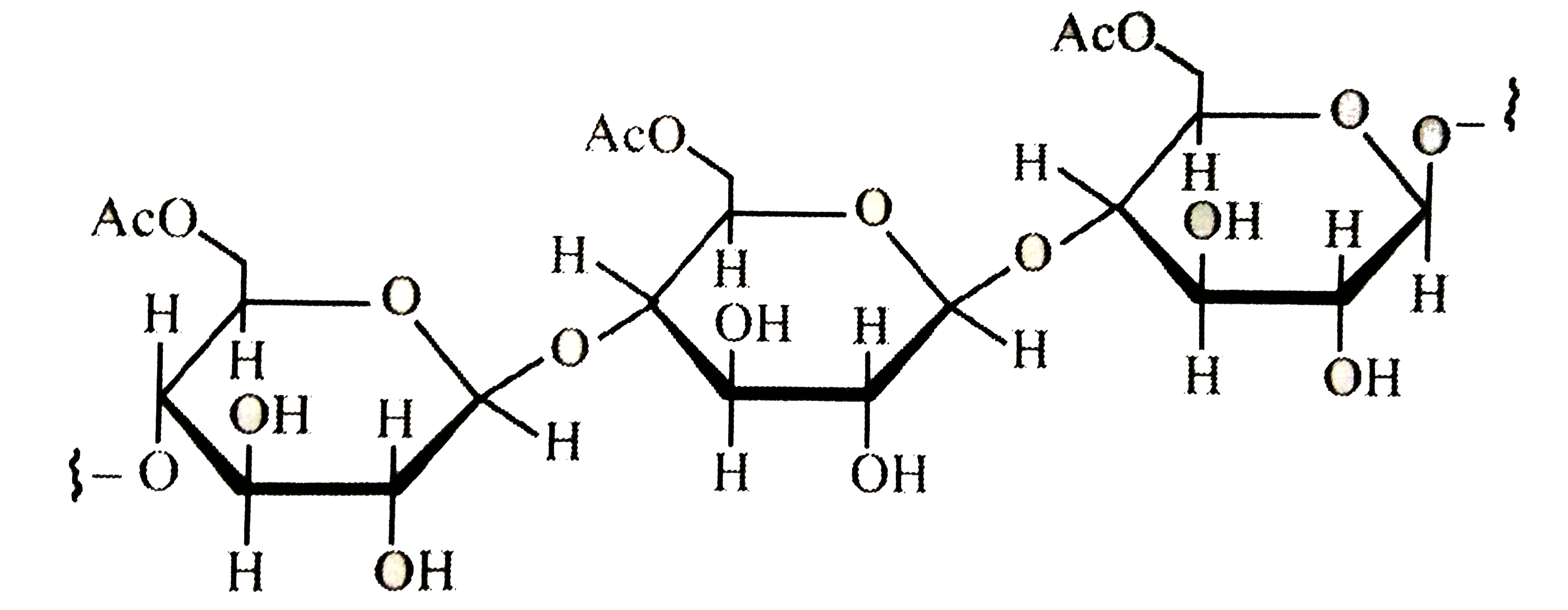Cellulose upon acetylation with excess acetic anhydride/H2SO4 (catalytic) gives cellulose triacetate whose structure is




The correct Answer is:A
To solve the question regarding the structure of cellulose triacetate formed from the acetylation of cellulose, we can follow these steps:
Step 1: Understand the Structure of Cellulose
Cellulose is a polysaccharide made up of β-glucose units linked by β-1,4-glycosidic bonds. Each glucose unit has multiple hydroxyl (–OH) groups that can undergo acetylation.
Hint: Recall that cellulose is a linear polymer of β-glucose, and focus on the repeating units.
Step 2: Identify the Acetylation Process
Acetylation is a chemical reaction where hydroxyl groups (–OH) in the cellulose are replaced by acetyl groups (–OCOCH₃). This reaction typically requires acetic anhydride and a catalyst such as sulfuric acid (H₂SO₄).
Hint: Remember that acetylation replaces hydrogen atoms in hydroxyl groups with acetyl groups.
Step 3: Draw the Structure of Cellulose
Start by drawing the repeating unit of cellulose, which is the β-glucose unit. Each unit will have a specific arrangement of hydroxyl groups.
Hint: Pay attention to the orientation of the hydroxyl groups in the β-glucose structure.
Step 4: Modify the Structure for Acetylation
Replace each hydroxyl group (–OH) in the cellulose structure with an acetyl group (–OCOCH₃). Since cellulose has three hydroxyl groups per glucose unit, each will be replaced by an acetyl group during the acetylation process.
Hint: Count the number of hydroxyl groups in the cellulose structure to ensure you replace all of them.
Step 5: Finalize the Structure of Cellulose Triacetate
After replacing all hydroxyl groups with acetyl groups, you will arrive at the structure of cellulose triacetate. This structure will consist of the original cellulose backbone with three acetyl groups attached.
Hint: Make sure to check that the final structure maintains the integrity of the cellulose backbone while incorporating the acetyl groups.
Conclusion
The final structure of cellulose triacetate will show a linear chain with acetyl groups replacing the hydroxyl groups. This structure is important in understanding the properties and applications of cellulose derivatives.
Summary of the Final Structure
- Cellulose triacetate will have a repeating unit of the cellulose backbone with three acetyl groups attached.
- The structure can be represented as follows:
OCOCH₃|−O−(Cello–sebackbo≠)|OCOCH₃|−O−(Cello–sebackbo≠)|OCOCH₃
Cellulose is a polysaccharide made up of β-glucose units linked by β-1,4-glycosidic bonds. Each glucose unit has multiple hydroxyl (–OH) groups that can undergo acetylation.
Acetylation is a chemical reaction where hydroxyl groups (–OH) in the cellulose are replaced by acetyl groups (–OCOCH₃). This reaction typically requires acetic anhydride and a catalyst such as sulfuric acid (H₂SO₄).
Start by drawing the repeating unit of cellulose, which is the β-glucose unit. Each unit will have a specific arrangement of hydroxyl groups.
Replace each hydroxyl group (–OH) in the cellulose structure with an acetyl group (–OCOCH₃). Since cellulose has three hydroxyl groups per glucose unit, each will be replaced by an acetyl group during the acetylation process.
After replacing all hydroxyl groups with acetyl groups, you will arrive at the structure of cellulose triacetate. This structure will consist of the original cellulose backbone with three acetyl groups attached.
The final structure of cellulose triacetate will show a linear chain with acetyl groups replacing the hydroxyl groups. This structure is important in understanding the properties and applications of cellulose derivatives.
- Cellulose triacetate will have a repeating unit of the cellulose backbone with three acetyl groups attached.
- The structure can be represented as follows:
Topper's Solved these Questions
- BIOMOLECULESBOOK - NCERT FINGERTPS ENGLISHCHAPTER - BIOMOLECULESEXERCISE - EXEMPLER PROBLEMS
16 Videos
- BIOMOLECULESBOOK - NCERT FINGERTPS ENGLISHCHAPTER - BIOMOLECULESEXERCISE - ASSERTION & REASON
15 Videos
- BIOMOLECULESBOOK - NCERT FINGERTPS ENGLISHCHAPTER - BIOMOLECULESEXERCISE - Assertion And Reason
15 Videos
- AMINES BOOK - NCERT FINGERTPS ENGLISHCHAPTER - AMINES EXERCISE - ASSERTION & REASON CORNER
14 Videos
- CHEMICAL KINETICSBOOK - NCERT FINGERTPS ENGLISHCHAPTER - CHEMICAL KINETICSEXERCISE - Assertion And Reason
15 Videos
Similar Questions
Knowledge Check
Acetone on heating with conc. H2SO4 mainly gives
AmesityleneBmesityl oxideCtolueneDxylene.
Anhydride of H2SO4 is _______ .
View SolutionState the name of anhydride of H2SO4.
View SolutionChromic anhydride in H2SO4 is not blue by:
View SolutionMethanol on heating with salicylic acid and cond . H2SO4 gives :
View SolutionAction of acetylene on dilute H2SO4 gives
View SolutionElectrolysis of H2SO4 (conc.) gives the following at anode
View SolutionThe ionisation of acetic acid in H2SO4 compared to in water, is :
View Solution
